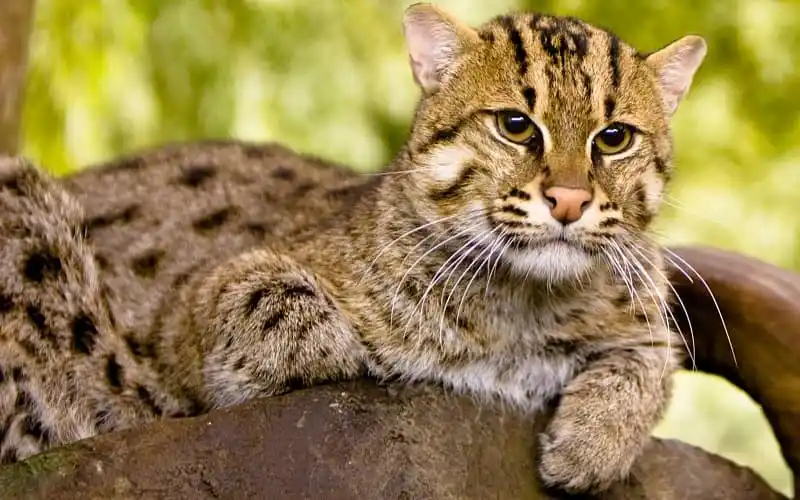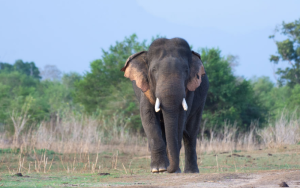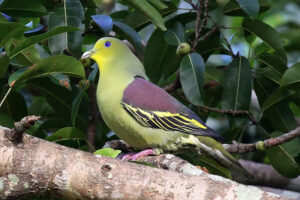About Fishing Cat
Not to be confused with the fisher (animal), a mustelid that is occasionally referred to as a “fishing cat,” nor with the Van cat, a landrace of domestic cat that is frequently referred to as the “swimming cat.”
South and Southeast Asia are home to the fishing cat, which is a medium-sized wild cat with a distinctive striped tail. Since 2016, it has been designated as Vulnerable on the International Union for Conservation of Nature Red List.
Fishing cat populations are threatened by the degradation of wetlands, and their numbers have plummeted dramatically over the last decade as a result. The fishing cat is most commonly found in the area of wetlands, along rivers and streams, in oxbow lakes, in swamps, and in mangroves, among other places.
The fishing cat is the state animal of West Bengal, and it can also be found in Sri Lanka, according to National Geographic.

Taxonomy of Fishing Cat
Edward Turner Bennett, who reported a fishing cat skin from India in 1833, recommended the name Felis viverrinus for the species. Species of spotted wild cats native to Asia were given the genus name Prionailurus in 1858 by Russian zoologist Nikolai Severtzov.
A new species of the fishing cat was proposed in 1936 by Henri Jacob Victor Sody, who described a specimen from the north coast of West Java with a somewhat shorter skull than fishing cat specimens from Thailand. The species is now known as Felis viverrinus rhizophoreus.
Phylogeny
According to a phylogenetic examination of nuclear DNA in tissue samples from all Felidae species, the evolutionary radiation of the Felidae began in Asia during the Miocene epoch between 14.45 and 8.38 million years ago and ended there approximately 8.38 million years ago. The mitochondrial DNA of all Felidae species has been analyzed, and it has been determined that radiation occurred approximately 16.76 to 6.46 million years ago.
Prionailurus species are thought to have shared a common ancestor between 8.16 and 4.53 million years ago and between 8.76 and 0.73 million years ago, according to current estimates.
Neither model disputes that the rusty-spotted cat (Prionailurus rubiginosus) was the first cat of the Prionailurus lineage to undergo genetic divergence, which was followed by the flat-headed cat (Prionailurus planiceps) and subsequently the fishing cat.
This species, together with the leopard cat (P. bengalensis), is thought to have diverged between 4.31 and 1.74 million years ago and 4.25 and 0.02 million years ago, respectively. The evolutionary relationships of the fishing cat, as determined by nuclear DNA study, are depicted in the cladogram below.

Characteristics of Fishing Cat
There are black lines and dots on the fishing cat’s fur, which is a rich yellowish-grey coloration. Stripes are drawn on the cheekbones, and two more are drawn over the eyes and down to the neck, with broken lines drawn on the forehead. There are two rows of dots around the throat of this creature.
When viewed from above, the shoulder spots are long and narrow; those on the sides, limbs, and tail are more round in shape. Individuals differ in the color of their background fur, which ranges from yellowish tawny to ashy grey, as well as the size of their stripes, which range from thin to large. The fur on the belly is lighter in color than the fur on the back and sides of the animal.
The ears are short and rounded, and they are situated low on the head. The back of the ears has a white patch on them. In comparison to the head and body, the tail is short, measuring less than half the length of the body, and it has a few black rings at the end.
The fur is layered to accommodate the aquatic environment. A small, thick layer serves as a water barrier and thermal insulation, while the second layer of protruding long guard hairs offers the pattern and glossy sheen to the hairstyle overall.
The fishing cat is the largest of the Prionailurus’s cats, and it is also the most aggressive. It has medium to short legs and is about twice the size of a domestic cat. It is stocky and muscular, with stocky and muscular legs. From the top of its head to the bottom of its body, it measures 57 to 78 cm (22 to 31 in) in length, with a tail that measures 20 to 30 cm (7.9 to 11.8 in).
Female fishing cats range in weight from 5.1 to 6.8 kg (11 to 15 lb), whereas male fishing cats range in weight from 8.5 to 16 kg (19 to 35 lb), indicating a significant difference in size between the sexes for a cat of this size. Its skull is elongated, with a basal length of 123–153 mm (4.8–6.0 in) and a post-orbital width of 27–31 mm (1.1–1.2 in), and it has a post-orbital width of 27–31 mm (1.1–1.2 in).
Although it has fewer webbed paws than the leopard cat, its claws are not totally sheathed, allowing them to protrude somewhat when the claws are retracted, as is the case with the leopard cat.
Although webbed feet have been recognized as a trait of the fishing cat, the webbing beneath the toes is not significantly more developed than that of a bobcat, which is a common misconception.
Fishing cat’s fur is a rich yellowish-grey coloration. Stripes are drawn on the cheekbones, and two more are drawn over the eyes and down to the neck. The ears are short and rounded, and they are situated low on the head. The fishing cat is the largest of the Prionailurus’s cats. It has medium to short legs and is about twice the size of a domestic cat. Although webbed feet have been recognized as a trait, the webbing beneath the toes is not significantly more developed than that of a bobcat.

Distribution and Habitat of Fishing Cat
The fishing cat is found throughout South and Southeast Asia, though its distribution is inconsistent. It is strongly connected with wetlands, occupying swamps and marshy areas near oxbow lakes, reed beds, tidal creeks, and mangrove forests; however, it appears to be less common around smaller, faster-moving watercourses, such as rivers and streams. The majority of the records come from lowland areas.
It was discovered in the Chotiari Dam area of Pakistan’s Sindh Province in 2012 that the fishing cat was present.
It has been observed in Shuklaphanta, Bardia, Chitwan, and Parsa National Parks, as well as the Koshi Tappu Wildlife Reserve, all of which are located in the Nepal Terai.
Its presence in India has been documented in the following places:
There are tigers in Ranthambore National Park, the Dudhwa and Valmiki Tiger Reserves, the Sur Sarovar Bird Sanctuary, and other areas outside protected areas in West Bengal, the Lothian Island Wildlife Sanctuary in the Sundarbans, the Bhitarkanika Wildlife Sanctuary in Odisha, and coastal districts outside protected areas in Andhra Pradesh, and the Coringa Wildlife Sanctuary, Krishna Wildlife Sanctuary, and adjacent reserve forests in Andhra Pradesh.
According to reports in Bangladeshi publications, fishing cats can be found in all divisions of the country, but they are in grave danger. Between January 2010 and March 2013, people killed at least 30 fishing cats, according to reports. It has been observed in a number of locations in Sri Lanka, ranging from coastal to hilly terrain.
In Myanmar, it was discovered in the Ayeyarwady Delta in 2016 and 2018, and it is expected to return in 2019.
Thai authorities have confirmed the presence of the animal in several locations, including Khao Sam Roi Yot National Park and Thale Noi Non-Hunting Area near the coast, and Kaeng Krachan National Park.
Aside from Phitsanulok Province, it was also discovered near wetlands outside protected areas in Bang Khun Thian District, Samut Sakhon Province, Phetchaburi and Songkhla Provinces, and near a mangrove location in Pattani between 2007 and 2016.
In March 2003, a single fishing cat was captured on film by a camera trap in Cambodia’s Kulen Promtep Wildlife Sanctuary, which was used to photograph it. A fishing cat kitten was discovered in Botum-Sakor National Park in 2008, according to local reports. Additionally, it was discovered at the Peam Krasop Wildlife Sanctuary in 2015.
However, by the 1990s, fishing cats had become scarce and appeared to be restricted to tidal forests with sandy or muddy beaches, older mangrove stands, and abandoned mangrove plantation areas with fishponds, which were all on the island of Java. Peninsular Malaysia, Vietnam, and Laos do not have any confirmed cases of the disease.
The fishing cat is strongly connected with wetlands, occupying swamps and marshy areas near oxbow lakes, reed beds, tidal creeks, and mangrove forests. It appears to be less common around smaller, faster-moving watercourses, such as rivers and streams. It is expected to return to Myanmar in 2018, and Thailand in 2019. Peninsular Malaysia, Vietnam, and Laos do not have any confirmed cases of the invasive feline.

Behaviour and Ecology of Fishing Cat
The fishing cat is known to be predominantly nocturnal in nature, and it prefers to stay near bodies of water. It has the ability to swim for vast distances, even underwater.
Adult males and females who do not have dependent young live in a solitary environment. Females have been observed to roam over ranges ranging from 4 to 6 km2 (1.5 to 2.3 sq mi), whilst males have been known to range over areas ranging from 16 to 22 km2 (6.2 to 8.5 sq mi). People have reported hearing adults chuckling at various times.
Its primary food is fish, which accounts for nearly three-quarters of its diet, according to scat samples taken in India’s Keoladeo National Park. The remaining quarter of its diet is composed of birds, insects, and small rodents, according to the same study.
Mollusks, reptiles, including snakes, amphibians, and carrion from domestic cattle are used to complement the diet of this species. While hunting along the borders of watercourses, fishing cats have been spotted taking prey from the water and occasionally diving into the water to catch prey that is further away from the banks.
It leaves smell traces on its home range by touching the cheeks, rubbing the head, rubbing the chin, rubbing the neck, and wiping the neck with urine. It also sharpens its claws and flashes its flehmen when threatened.
Reproduction and Development
Wild fishing cats are most likely to mate during the months of January and February, and the majority of kittens have been spotted in the wild during the months of March and April. In captivity, the gestation cycle lasts 63–70 days, during which time the females give birth to two or three kittens every litter.
The average weight of a newborn is approximately 170 g (6.0 oz), and they are able to move around on their own by the age of one month. Their first experiences with water and solid food occur about two months of age, but they are not completely weaned until they are six months old.
Adult stature is reached by roughly eight and a half months of age, and the canine teeth of the adult stage are acquired by 11 months of age. Sexual maturity is reached by approximately 15 months of age. In captivity, they can live for up to ten years.

Threats to Fishing Cat
A major concern to the fisher cat is the degradation of wetlands, which are progressively being contaminated and converted for agricultural use and human settlements.
Human-animal conflict in Andhra Pradesh is exacerbated by the conversion of mangrove forests into commercial aquaculture ponds, which is also exacerbated by the purposeful slaughter of fishing cats in areas where there is human-animal conflict. In addition, over-exploitation of local fish stocks, as well as retaliatory killing, pose serious concerns.
Between April 2010 and May 2011, a total of 27 dead fishing cats were discovered in the Howrah district of West Bengal. In Bangladesh, between January 2010 and March 2013, at least 30 fishing cats were killed by locals over a three-year period, according to official figures. Another finding was that of all the fishing cats that were monitored using radio collars in Thailand, 84 percent of them were murdered, either as a result of poaching or for unknown reasons.
Conservation
Hunters are barred from entering the following countries: Bangladesh; Cambodia; China; India; Indonesia; Myanmar; Nepal; Pakistan; Sri Lanka; and Thailand. Hunting rules are in effect in the Lao People’s Democratic Republic.
Aside from protected areas in Bhutan and Vietnam, the species is not protected outside of those locations. Its survival is dependent on the preservation of wetlands, the prevention of indiscriminate trapping, snaring, and poisoning, as well as other factors.
Environmental non-governmental organizations (NGOs) are working with local communities in regions where habitat degradation is a major problem, such as coastal Andhra Pradesh, to decrease the rate of habitat conversion. This approach includes the development of alternative livelihood initiatives that enable villages to earn money while minimizing the impact on natural environments.

In captivity
European Association of Zoos and Aquaria (EAZA) and the American Association of Zoos and Aquariums (AAZA) have launched captive breeding programs for fishing cats, which are now in their second generation. The International Studbook of the World Association of Zoos and Aquariums contains a comprehensive listing of all of the fishing cats that are housed in zoos across the world.
Local Names
In Assamese, the fishing cat is known as meseka , probabl derived from mas meaning “fish”.
In Bengali, the fishing cat is known as “mach-baghrol” and “bagh-dasha”. “Mācha” means “fish”, and “bāgha” means “tiger”.
In Hindi, it is known as “bunbiral” and “khupya bagh”.
In Telugu, it is called “bavuru pilli” meaning “wild cat”.
In Sinhala, the fishing cat is known as “handun diviya”.
In Thai, it is called “suea pla”, literally “fish tiger”.
In Myanmar language, it is called “Kyaung-ta-nga” “Kyaung” means “cat” and “ta-nga” means “fisherman”
Conclusion
In conclusion, the Fishing Cat is a unique and elusive feline species found in Sri Lanka that plays a crucial role in maintaining the ecological balance of its habitat. With its exceptional hunting abilities and adaptation to aquatic environments, the Fishing Cat is a fascinating animal to observe and study.
However, like many other wildlife species, the Fishing Cat is facing significant threats, including habitat loss, poaching, and human-wildlife conflicts. It is essential to implement conservation efforts to protect these endangered cats and their habitats, such as creating protected areas, promoting responsible tourism, and implementing sustainable development practices.
As responsible travelers, we can play a vital role in preserving the Fishing Cat and its habitat by supporting sustainable tourism initiatives that prioritize the protection of these cats and their natural environment. By doing so, we can help conserve this magnificent feline species for future generations to appreciate and admire.
Travel Accessories
We provide the best products for your travel needs which have been carefully selected for our visitors from our Affiliate Partner – Amazon.











5 thoughts on “Fishing Cat – Mammals – Sri Lanka”
naturally like your web site however you need to take a look at the spelling on several of your posts. A number of them are rife with spelling problems and I find it very bothersome to tell the truth on the other hand I will surely come again again.
Really no matter if someone doesn’t know then its up to other users that they will help, so here it happens.
I have really learned newer and more effective things from your blog post. One more thing to I have observed is that usually, FSBO sellers may reject a person. Remember, they’d prefer to not ever use your expert services. But if you maintain a reliable, professional romance, offering guide and staying in contact for about four to five weeks, you will usually be capable of win interviews. From there, a house listing follows. Many thanks
This theme is simply matchless :), very much it is pleasant to me)))
Thanks for your publication.